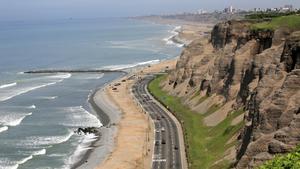
photo by Alex Proimos

A fall in crime over recent years, coupled with a rise in bohemian culture has led to a certain degree of gentrification in Peru’s capital. However its Latin restlessness and historic sites remain as awe inspiring as ever, meaning there’s never been a better time to visit, or even live in Lima.
The historic centre revolves around the Plaza de Armas, located on the site where Francisco Pizarro and his conquistadores founded what was to eventually become Lima as it is today. On the Plaza de Armas you can find the Government Palace, where the President works and resides, along with the Cathedral of Lima and the garish yellow Municipal Hall.
The Cathedral is open for public tours and costs US$1.50, with discounts available for students and kids. Whilst the other two don’t offer tours, they’re definitely worth admiring from the outside.
Also worth a visit is the San Francisco church. Most striking are its impressive Baroque architecture and the swathes of pigeons that congregate outside to be fed by tourists. Beneath the church are extensive yet claustrophobic catacombs, estimated to hold up to 75,000 bodies dating back to the Spanish conquest. Tours cost around US$2.
Along with historic sightseeing, Lima has several fashionable, lively districts, the foremost of these being the Barranco area. Visitors can flit between a vast array of bars and clubs, playing a diverse range of music but always keeping the Latin energy. During the daytime its a great place to enjoy the sea views, especially from the Bridge of Sighs. Rumour has it that if you hold both your breath and the hand of your loved one whilst crossing it, you can look forward to a successful love life together.

photo by Alex Proimos
It’s definitely worth exploring the Miraflores neighbourhood. Spend a morning ambling through El Malecón, a sprawling green park sat atop cliffs rising far above the Pacific Ocean. It offers ample opportunities for cycling, walking or running whilst you struggle to take in the amazing views encroaching from all sides.
Miraflores also plays host to Larcomar, a huge commercial complex built into the side of these same cliffs. Inside is a vast selection of places to eat and shop, as well as a glass front providing unrivalled views of the ocean below. The district is also rammed with drinking spots and provides great opportunities to soak up the local culture and atmosphere.
A slightly quirkier attraction is the Magic Water Circuit, found within the Parque de la Reserva. This impressive selection of illuminated water fountains has won a Guinness World Record for being the largest of its kind in the world. The huge array of fountains range from water tunnels and mazes you can walk through to single spouts that shoot 80 metres into the air. It is best enjoyed at night, when the beautiful colours and lights really come to life. Entry costs 4 Soles (about US$1.50).
There are a great selection of bars, restaurants and markets throughout the city. As with many Latin American capitals, the markets offer some of the best opportunities to explore and really get a feel of what the city, and the people, are all about. In Lima one of the best markets is the Mercado Central, located near the Congress. The food selection ranges from fresh fruit to guinea pig, as well as tasty cooked meals you can sit down to enjoy. There is also plenty of other trinkets available such as clothes, bags, accessories and books.
As mentioned before, Barranco and Miraflores districts offer a huge array of places to both eat and drink. In Peru the must try food is ceviche, a dish of raw fish served with lime juice and hot chillies. Whilst it might not sound appetising to some, it works surprisingly well, and has to at least be tried out of curiosity.
Pisco Sour is the great national drink and is almost omnipresent throughout not only Lima but Peru as a whole. Made with the Peruvian spirit pisco, combined with egg white and lime juice amongst other ingredients, it makes for a thick cocktail that’s simultaneously refreshing and invigorating.
Lima’s position in the middle of the west coast means its very well connected with the rest of the country. Buses run to and from the capital from most other big towns. Its main airport, Jorge Chávez, won an award in 2012 for being the best international airport on the continent. There are many domestic and international flights running on a daily basis.
More information on this can be found under the travel section for Peru.